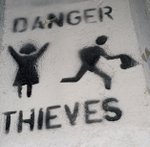JUBILEE CITY
A Memoir at Full Speed
By Joe Andoe
Illustrated. 207 pages. William Morrow. $22.95.
Living and Painting by His Own Rules
Joe Andoe grew up in Tulsa, Okla., living a life straight out of Chuck Palahniuk’s twisted imagination. Mama was a gum-popping cutie. Little Joe was “a big slug of a baby.” His mother says she didn’t see much of him during his formative years. “My only explanation,” he writes, “is that I tried to stay the hell out of the way.”
One afternoon he was watching a Popeye cartoon with his grandfather, a “silver-tongued womanizer” who was 6 feet 5 inches tall and part Cherokee. Popeye inspired the boy to start drawing. He drew versions of Popeye’s tattoos on his grandfather’s arms and chest. Later, after the wild times that his book revisits, he would grow up to parlay this gift into a career as a cowboy artist.
“Since the late ’70s I have fancied myself a landscape painter, and a painter of the things that hang around on the landscape,” Mr. Andoe writes in “Jubilee City.” This memoir, an expanded version of a book he published privately in 2005, includes enough pictures to convey what he means. The style of the paintings is “psychedelic but real,” reminiscent of the music of the Byrds circa 1969. These compositions aspire to an eerie, evocative stillness, “like the stillness at twilight when animals come out into the open.”
Not every painter of lonely landscapes and stark, haunting creatures has a readable story to tell. But Mr. Andoe makes this book a natural offshoot of his art, combining cool understatement with brass-tacks candor. “ ‘Jubilee City’ is about a kid from the edge of town and his curiosity and hunt for some kind of ideal redneck grandiosity and how he operated and got by under a law of his own,” he writes. “Mostly this book is a testament to weaving sticks and trash into something that can hang in a nice place.”
As a man who “caught the art virus” from an Andy Warhol poster and eventually accomplished something not even Hunter Thompson could do — get himself thrown out of the Woody Creek Tavern in Aspen, Colo., a place where Mr. Thompson could set off firecrackers with impunity — he had no gift for towing the line in Tulsa. At an early age he “mastered the low art of coming unmoored.”
His book — which is divided into short anecdotes given painterly names (“Spontaneous Radiance,” “Keepsake,” “Tire Patch,” “Head Case”) — catalogs these teenage antics with aplomb. One involves having been handcuffed by the police after a mishap involving his motorcycle. About this, he writes: “Sometimes it’s too late to make a first impression.”
Mr. Andoe’s teenage years were wild enough to leave some of his friends lost forever. One of the happier stories here describes how a buddy with a bottle of whiskey in his back pocket sat down, felt something break, sensed liquid flowing behind him and said, “God, I hope that’s blood.” Without aggrandizing the train-wreck aspect of these memories, Mr. Andoe conveys a strong sense of how his own success, in the arts of both painting and survival, amounts to a lucky roll of the dice.
“Jubilee City” also gives him a forum for settling old grudges. And he does this with malevolent glee. “My mother-in-law was these two things: the meanest person I have ever known, and the one who has hated me the most.” As for his wife, he describes their moment at the altar with nothing if not visual imagination. “She looked at me and she gave me a look like a dog that’s fixing to bite my face,” he recalls.
There is similar bile for the Tulsa museum that refused to hang his work until it had to, after Mr. Andoe was one of the artists included in a traveling show from the Metropolitan Museum of Art. Eventually this would become reason to leave Tulsa and head north.
He describes joyless married life in both Jersey City and downtown Manhattan, and a workaholism that struck his more entitled artist friends as foolhardy. “There were always millions of reasons not to paint and it looked like some of them felt they didn’t have to anyway, because it was really just a matter of meeting the right person and then getting hooked up with the right gallery,” he writes. He himself was more focused. “I was lucky enough to know that my strength lay in my hands, not in my social skills,” he writes. “My only choice was to make my next painting better than the last.”
It worked — to the extent that he got the Cinderella treatment from the Swiss art dealer Thomas Ammann, developed a following, quit drinking, became a doting father and started having better luck with women. This choppy, jet-fueled book ends with one last symbolic joy ride on his motorcycle. But it suggests no end to the rebellious streak that got him out of Tulsa and allowed him to live life on his own terms. Mr. Andoe’s whole career and his penchant for painting pensive-looking horses began as an expression of that independence.
“It was like of all the eight million people in New York, no one remembered the plainness of culture before disco,” he writes about the city in the 1980s. “Everyone in New York was different from me and horses became shorthand for that.”





